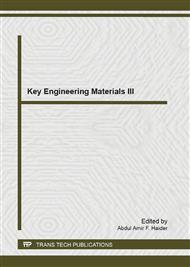p.319
p.323
p.329
p.333
p.337
p.342
p.349
p.354
p.359
Mathematical Modelling of Urea-Formaldehyde Polymerization Kinetics Using Mechanism Approach
Abstract:
Nowadays, formaldehyde is considered to be a hazardous volatile chemical. One of the formaldehyde sources is urea-formaldehyde resin which is mainly used as an adhesive in particleboard production. Hence, it is necessary to minimize the formaldehyde residue from urea-formaldehyde synthesis. This present work involves the kinetic modelling of urea-formaldehyde polymerization to predict formaldehyde concentration during the pre-polymerization process. On the basis of previous proposed mechanism, the kinetic model which accounted for the number of the functional groups on urea and formaldehyde and also reactive polymer chains was developed as a set of ordinary differential equations (ODEs). The formaldehyde concentrations from computer simulation results were compared with those from experimental investigation. Good agreement between simulation and experimental results was obtained. The developed kinetic model can be also applied to predict the functional group evolution during polymerization. This helps producers select the condition for production to minimize formaldehyde residue and predict the chemical structure of final product.
Info:
Periodical:
Pages:
337-341
Citation:
Online since:
May 2013
Authors:
Keywords:
Price:
Сopyright:
© 2013 Trans Tech Publications Ltd. All Rights Reserved
Share:
Citation:


